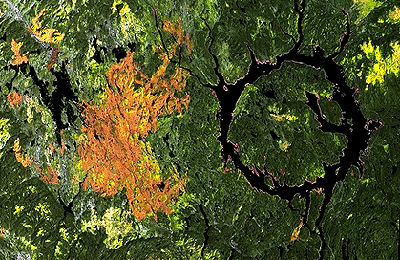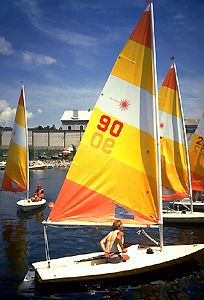Browse "Science & Technology"
-
Article
Hydrofoil
Attempts to create a hydrofoil were made in England as early as 1861. A hydrofoil sustains its motion by the lift achieved by hydrofoil-plates that function in the water as airplane wings do in the air.
"https://d2ttikhf7xbzbs.cloudfront.net/media/media/6cecea23-75d7-45b5-b758-2f53a1b5bce7.jpg" // resources/views/front/categories/view.blade.php
https://d2ttikhf7xbzbs.cloudfront.net/media/media/6cecea23-75d7-45b5-b758-2f53a1b5bce7.jpg
-
Article
Hydrogen
Hydrogen (H), the simplest, lightest and most abundant chemical element, is the main fuel for the nuclear fusion reactions which power the sun.
"https://development.thecanadianencyclopedia.ca/images/tce_placeholder.jpg?v=e9dca980c9bdb3aa11e832e7ea94f5d9" // resources/views/front/categories/view.blade.php
https://development.thecanadianencyclopedia.ca/images/tce_placeholder.jpg?v=e9dca980c9bdb3aa11e832e7ea94f5d9
-
Article
Hydrography
Hydrography is the science of surveying, charting and describing physical features of Oceans, seas, Rivers and Lakes.
"https://d2ttikhf7xbzbs.cloudfront.net/media/media/4aad02e3-72bd-400c-87ab-d1380ccad4dc.jpg" // resources/views/front/categories/view.blade.php
https://d2ttikhf7xbzbs.cloudfront.net/media/media/4aad02e3-72bd-400c-87ab-d1380ccad4dc.jpg
-
Article
Hydrology
Quantitative measurements of rainfall, snowfall, the rate at which water penetrates into and moves through soil, streamflow, the rise and fall of LAKE and GROUNDWATER levels, and the evapotranspiration of water into the atmosphere are vital.
"https://development.thecanadianencyclopedia.ca/images/tce_placeholder.jpg?v=e9dca980c9bdb3aa11e832e7ea94f5d9" // resources/views/front/categories/view.blade.php
https://development.thecanadianencyclopedia.ca/images/tce_placeholder.jpg?v=e9dca980c9bdb3aa11e832e7ea94f5d9
-
Article
Ice Age
Ice Age, the Pleistocene epoch of geologic time, during which periodic, extensive glacial activity occurred in many parts of the world.
"https://development.thecanadianencyclopedia.ca/images/tce_placeholder.jpg?v=e9dca980c9bdb3aa11e832e7ea94f5d9" // resources/views/front/categories/view.blade.php
https://development.thecanadianencyclopedia.ca/images/tce_placeholder.jpg?v=e9dca980c9bdb3aa11e832e7ea94f5d9
-
Article
Icebreakers
Icebreakers were first used in the Canadian Arctic in the 1920s to deliver supplies and services to Native and isolated settlements during the short summer season, and to back up claims of Canadian sovereignty over the NORTHWEST PASSAGE and ARCTIC ARCHIPELAGO.
"https://d2ttikhf7xbzbs.cloudfront.net/media/media/737e507c-57e6-4b84-9ef9-d68151cd83af.jpg" // resources/views/front/categories/view.blade.php
https://d2ttikhf7xbzbs.cloudfront.net/media/media/737e507c-57e6-4b84-9ef9-d68151cd83af.jpg
-
Article
IMAX Systems Corporation
IMAX emerged from the Expo 67 cultural context. Corporation co- founders Graeme Ferguson, Roman Kroitor and Robert Kerr all participated in some of the popular large- and multiple-screen film experiments that were part of the Montréal Expo.
"https://d2ttikhf7xbzbs.cloudfront.net/media/media/3b5bc0e7-c20e-439a-8722-6e4d6bfe8856.jpg" // resources/views/front/categories/view.blade.php
https://d2ttikhf7xbzbs.cloudfront.net/media/media/3b5bc0e7-c20e-439a-8722-6e4d6bfe8856.jpg
-
Article
Immunology
Immunology is a branch of MEDICINE that studies the body's ability to defend itself from foreign substances, cells and tissues, especially DISEASE-causing organisms, and seeks means of controlling that ability.
"https://development.thecanadianencyclopedia.ca/images/tce_placeholder.jpg?v=e9dca980c9bdb3aa11e832e7ea94f5d9" // resources/views/front/categories/view.blade.php
https://development.thecanadianencyclopedia.ca/images/tce_placeholder.jpg?v=e9dca980c9bdb3aa11e832e7ea94f5d9
-
Article
Meteors, Meteorites and Impact Craters
The solar system contains many objects smaller than the planets (or their satellites) travelling in individual orbits about the SUN; space between the planets also contains myriad dust grains in the micron size range. Near Earth, dust concentrations are only a few hundred particles per cubic kilometre, but 35 000 to 100 000 t of extraterrestrial material enters the atmosphere annually, swept up by our planet from debris that is in its path or crosses its path.
"https://d2ttikhf7xbzbs.cloudfront.net/media/media/66e2415e-3179-44e5-a06b-e73edf3aa050.jpg" // resources/views/front/categories/view.blade.php
https://d2ttikhf7xbzbs.cloudfront.net/media/media/66e2415e-3179-44e5-a06b-e73edf3aa050.jpg
-
Article
Industrial Archaeology
Industrial ARCHAEOLOGY is a type of interdisciplinary history that promotes understanding of the industrial era by focusing on physical remains, whether above ground or below, and by combining the insights of fieldwork and historical research.
"https://development.thecanadianencyclopedia.ca/images/tce_placeholder.jpg?v=e9dca980c9bdb3aa11e832e7ea94f5d9" // resources/views/front/categories/view.blade.php
https://development.thecanadianencyclopedia.ca/images/tce_placeholder.jpg?v=e9dca980c9bdb3aa11e832e7ea94f5d9
-
Article
Industrial Design
The major early developments in industrial design occurred in continental Europe, principally England, Germany and Scandinavia.
"https://d2ttikhf7xbzbs.cloudfront.net/media/media/d5e6c87c-7a50-418f-af6e-a5558582b230.jpg" // resources/views/front/categories/view.blade.php
https://d2ttikhf7xbzbs.cloudfront.net/media/media/d5e6c87c-7a50-418f-af6e-a5558582b230.jpg
-
Article
Industrial Quality Control
Industrial Quality Control uses scientific techniques to determine product and service capabilities, to enable an organization to economically provide a product or service suitable for its intended purpose.
"https://development.thecanadianencyclopedia.ca/images/tce_placeholder.jpg?v=e9dca980c9bdb3aa11e832e7ea94f5d9" // resources/views/front/categories/view.blade.php
https://development.thecanadianencyclopedia.ca/images/tce_placeholder.jpg?v=e9dca980c9bdb3aa11e832e7ea94f5d9
-
Article
Industrial Research and Development
Technological innovation is essential for economic growth and for the improvement of the quality of life. Industrial research and development (R & D) is at the heart of the innovative process.
"https://development.thecanadianencyclopedia.ca/images/tce_placeholder.jpg?v=e9dca980c9bdb3aa11e832e7ea94f5d9" // resources/views/front/categories/view.blade.php
https://development.thecanadianencyclopedia.ca/images/tce_placeholder.jpg?v=e9dca980c9bdb3aa11e832e7ea94f5d9
-
Article
Influenza (Flu) in Canada
Influenza, often referred to as the flu, is a common, contagious respiratory illness. There are four types of influenza viruses: A, B, C and D. While influenza A, B and C viruses can infect humans, influenza D is believed to primarily affect animals such as cattle and pigs. Influenza C is rare in comparison to influenza A and B, which are the main sources of the “seasonal flu,” or the viruses that circulate in Canada and other countries each winter. Influenza A is also the source of flu pandemics. Canada has experienced five influenza pandemics since the late 19th century, in 1890, 1918, 1957, 1968 and 2009. In Canada, influenza causes an estimated 12,200 hospitalizations and 3,500 deaths each year.
"https://d2ttikhf7xbzbs.cloudfront.net/media/media/73780e73-cf0f-4654-b6da-da083ddb6c53.jpg" // resources/views/front/categories/view.blade.php
https://d2ttikhf7xbzbs.cloudfront.net/media/media/73780e73-cf0f-4654-b6da-da083ddb6c53.jpg
-
Article
Information and Communications Technology
Communications technologies include the techniques, tools and methods used to facilitate communication. Information technologies include those used to create, record, modify and display the content being communicated.
"https://d2ttikhf7xbzbs.cloudfront.net/media/media/528dd8b2-60b3-4853-9b1a-8c6731b71fe4.jpg" // resources/views/front/categories/view.blade.php
https://d2ttikhf7xbzbs.cloudfront.net/media/media/528dd8b2-60b3-4853-9b1a-8c6731b71fe4.jpg
